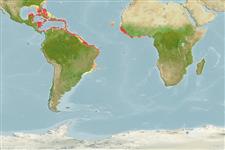Common names from other countries
Environment: milieu / climate zone / depth range / distribution range
Ecologia
marinhas associadas(os) a recifes; intervalo de profundidade 0 - 100 m (Ref. 5979), usually 0 - 20 m (Ref. 40849). Tropical; 34°N - 25°S, 91°W - 5°E
Western Atlantic: Florida (USA), Bermuda, and the Bahamas to Brazil. Absent in Gulf of Mexico (Ref. 26938). Eastern Atlantic: Ascension Island and the Gulf of Guinea (Ref. 5979).
Tamanho / Peso / Idade
Maturity: Lm ? range ? - ? cm
Max length : 46.0 cm TL macho/indeterminado; (Ref. 5979); common length : 35.0 cm TL macho/indeterminado; (Ref. 3275)
Raios dorsais moles (total): 92-99; Raios anais moles: 71 - 76. Gray to brown with numerous circles, curved spots, and dots of light blue on head and body; fins with small light blue spots; two or three large diffuse blackish spots on straight portion of lateral line (Ref. 13442).
Inhabits clear sandy areas near mangroves, among seagrass, coral or rubble (Ref.9710). Most common flounder around coral reefs (Ref. 26938). Often partially buried in sand, occasionally on hard bottoms (Ref. 9710). Feeds mainly on small fishes but also on crustaceans and octopuses. Marketed fresh (Ref. 5217).
Life cycle and mating behavior
Maturidade | Reprodução | Desova | Ovos | Fecundidade | Larvas
Robins, C.R. and G.C. Ray, 1986. A field guide to Atlantic coast fishes of North America. Houghton Mifflin Company, Boston, U.S.A. 354 p. (Ref. 7251)
Categoria na Lista Vermelha da IUCN (Ref. 130435)
CITES (Ref. 128078)
Not Evaluated
Ameaça para o homem
Harmless
Utilização humana
Pescarias: pouco comercial; Aquário: Espécies comerciais
Mais informação
Nomes comunsSinónimosMetabolismoPredadoresEcotoxicologiaReproduçãoMaturidadeDesovaFecundidadeOvosDesenvolvimento dos ovos
ReferênciasAquaculturaPerfil para aquaculturaEstirpesGenéticaElectrophoresesHereditariedadeDoençasProcessamentoMass conversion
Ferramentas
Relatórios especiais
Descarregue XML
Fontes da internet
Estimates based on models
Preferred temperature (Ref.
115969): 25.2 - 28, mean 27.3 (based on 368 cells).
Phylogenetic diversity index (Ref.
82804): PD
50 = 0.5000 [Uniqueness, from 0.5 = low to 2.0 = high].
Bayesian length-weight: a=0.01000 (0.00529 - 0.01890), b=3.09 (2.93 - 3.25), in cm Total Length, based on LWR estimates for this species & Genus-body shape (Ref.
93245).
Nível Trófico (Ref.
69278): 4.5 ±0.7 se; based on diet studies.
Resiliência (Ref.
120179): Muito baixo, tempo mínimo de duplicação da população maior que 14 anos (Preliminary K or Fecundity.).
Fishing Vulnerability (Ref.
59153): Moderate vulnerability (36 of 100).
